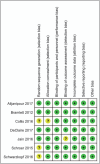Effectiveness of liposome bupivacaine for postoperative pain control in total knee arthroplasty: A PRISMA-compliant meta-analysis of randomized controlled trials
- PMID: 29595645
- PMCID: PMC5895431
- DOI: 10.1097/MD.0000000000010171
Effectiveness of liposome bupivacaine for postoperative pain control in total knee arthroplasty: A PRISMA-compliant meta-analysis of randomized controlled trials
Abstract
Background: Adequate pain control after total knee arthroplasty (TKA) enables quicker recovery and reduces readmissions and treatment costs. The aim of this study was to determine the effect of liposomal bupivacaine (LB) for postoperative pain control in patients prepared for TKA.
Methods: We searched for the reports that evaluating the effect of liposomal bupivacaine for postoperative pain control in patients prepared for TKA between March 1983 and May 2017 in the electronic database Cochrane Central Register of Controlled Trials (CENTRAL), PubMed, EMBASE, Web of Science, and Ovid. The main outcomes were visual analog scale (VAS) at 24, 48, and 72 hours. The secondary outcomes were total morphine consumption, the length of hospital stay, range of motion, and the occurrence of nausea.
Results: Seven randomized controlled trials (RCTs) enrolling 825 patients, with 413 in the LB group and 412 in the control group, were included in this meta-analysis. Our results suggested that administration LB was associated with a reduction of VAS by 4.22 points at 72 hours after TKA (WMD = -4.22, 95% CI -7.47, -0.97, P = .011) on a 100-point VAS. What's more, LB can decrease the occurrence of nausea when compared with traditional bupivacaine by 18.3% (risk ratio = 0.70, 95% confidence interval 0.55, 0.89, P = .003). LB was associated with an increase of the range of motion than traditional bupivacaine (P < .05). There was no significant difference between the VAS at 24, 48 hours, total morphine consumption and the length of hospital stay.
Conclusions: Administration with LB was associated with pain-relieving effects and reduces the morphine-related complications (nausea). Due the limited number of the included RCTs, large number and high quality RCTs are still need to identify the effects of LB for pain control after TKA.
Conflict of interest statement
The authors declare no conflicts of interest.
Figures
Similar articles
-
Comparison of periarticular anesthesia with liposomal bupivacaine with femoral nerve block for pain control after total knee arthroplasty: A PRISMA-compliant meta-analysis.Medicine (Baltimore). 2017 Mar;96(13):e6462. doi: 10.1097/MD.0000000000006462. Medicine (Baltimore). 2017. PMID: 28353580 Free PMC article.
-
The efficacy of liposomal bupivacaine compared with traditional peri-articular injection for pain control following total knee arthroplasty: an updated meta-analysis of randomized controlled trials.BMC Musculoskelet Disord. 2019 Jun 29;20(1):306. doi: 10.1186/s12891-019-2660-7. BMC Musculoskelet Disord. 2019. PMID: 31253119 Free PMC article.
-
Liposome bupivacaine for pain control after total knee arthroplasty: a meta-analysis.J Orthop Surg Res. 2016 Jul 22;11(1):84. doi: 10.1186/s13018-016-0420-z. J Orthop Surg Res. 2016. PMID: 27443874 Free PMC article.
-
No Difference in Early Analgesia Between Liposomal Bupivacaine Injection and Intrathecal Morphine After TKA.Clin Orthop Relat Res. 2017 Jan;475(1):94-105. doi: 10.1007/s11999-016-4931-z. Clin Orthop Relat Res. 2017. PMID: 27339124 Free PMC article. Clinical Trial.
-
Liposomal bupivacaine administration is not superior to traditional periarticular injection for postoperative pain management following total knee arthroplasty: a meta-analysis of randomized controlled trials.J Orthop Surg Res. 2023 Mar 16;18(1):206. doi: 10.1186/s13018-023-03699-4. J Orthop Surg Res. 2023. PMID: 36922892 Free PMC article.
Cited by
-
Risk factors for liposomal bupivacaine resistance after total hip or knee arthroplasties: a retrospective observational cohort in 237 patients.Patient Saf Surg. 2020 Jan 30;14:6. doi: 10.1186/s13037-020-0230-4. eCollection 2020. Patient Saf Surg. 2020. PMID: 32015758 Free PMC article.
-
A Novel Extended-Release Analgesic Without Periarticular Injection Provides Inferior Immediate Postsurgical Pain Relief in Total Hip and Knee Arthroplasty Patients.Arthroplast Today. 2025 May 5;33:101704. doi: 10.1016/j.artd.2025.101704. eCollection 2025 Jun. Arthroplast Today. 2025. PMID: 40458279 Free PMC article.
-
Comprehensive Comparison of Liposomal Bupivacaine with Femoral Nerve Block for Pain Control Following Total Knee Arthroplasty: An Updated Systematic Review and Meta-Analysis.Orthop Surg. 2019 Dec;11(6):943-953. doi: 10.1111/os.12547. Epub 2019 Nov 25. Orthop Surg. 2019. PMID: 31762223 Free PMC article.
-
Compared the Effectiveness of Intraperitoneal Bupivacaine with Lung Recruitment Maneuver Versus Normal Saline with Lung Recruitment Maneuver in Reducing Shoulder Pain After Laparoscopic Surgery: A Double-Blind Randomized Controlled Trial.Anesth Pain Med. 2024 Jul 14;14(3):e148198. doi: 10.5812/aapm-148198. eCollection 2024 Jun. Anesth Pain Med. 2024. PMID: 39416802 Free PMC article.
-
A guide to regional analgesia for Total Knee Arthroplasty.EFORT Open Rev. 2021 Dec 10;6(12):1181-1192. doi: 10.1302/2058-5241.6.210045. EFORT Open Rev. 2021. PMID: 35839095 Free PMC article.
References
-
- Rutherford RW, Jennings JM, Dennis DA. Enhancing recovery after total knee arthroplasty. Orthop Clin North Am 2017;48:391–400. - PubMed
-
- Terkawi AS, Mavridis D, Sessler DI, et al. Pain management modalities after total knee arthroplasty: a network meta-analysis of 170 randomized controlled trials. Anesthesiology 2017;126:923–37. - PubMed
-
- Wheeler M, Oderda GM, Ashburn MA, et al. Adverse events associated with postoperative opioid analgesia: a systematic review. J Pain 2002;3:159–80. - PubMed
Publication types
MeSH terms
Substances
LinkOut - more resources
Full Text Sources
Other Literature Sources
Medical




